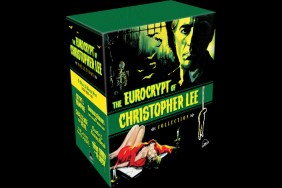
On its 55th anniversary, SHOCK looks at Roger Corman’s terrifying THE PIT AND THE PENDULUM.
Though he has made hundreds of films (and is currently making a companion movie to his 1975 classic DEATH RACE 2000), spanning over six decades, producer/director and indie genre film pioneer Roger Corman’s 8-picture “Poe Cycle” continues to be among his most celebrated and discussed works.
The story goes that Corman, who was, by the end of the 1950’s becoming fledgling studio American International Pictures’ regular house producer/director, went to AIP bosses Sam Arkoff and Jim Nicholson and convinced them to take the budget they’d normally use for two black and white pictures and instead combine them to make a single full color movie. The studio initially balked but eventually relented and the first entry in that experiment was 1960’s HOUSE OF USHER, based on the classic Edgar Allan Poe tale, “The Fall of the House of Usher”.
The Gothic, lushly realized film, written by popular writer and novelist Richard Matheson (“I Am Legend”, “Hell House”, THE TWILIGHT ZONE), was a rousing critical and commercial success, a picture that bridged the gap between the drive-ins and teen-drenched “flat tops” that Corman and AIP catered to, and the arthouse, with a distinctly literate and moody European sheen that most exploitation films of the time simply didn’t have.
But as to which of the 8 remarkable Poe films is the superior entry, It’s subjective, Certainly, everyone has their favorite and latter works like the shot in England, Ingmar Bergman-influenced MASQUE OF THE RED DEATH and TOMB OF LIGEIA are the most sumptuously designed of the lot. But his HOUSE OF USHER follow-up, 1961’s THE PIT AND THE PENDULUM, is inarguably the scariest…

In PIT, the great Vincent Price returned after his mesmerizing work as Roderick Usher the previous year, this time with his trademark facial hair back on his face, to devour scenery with maniacal, operatic aplomb, losing himself in the role of the tortured Nicholas Medina, a man decimated after the death of his beloved wife (played by the gorgeous Barbara Steele, fresh off her role in Mario Bava’s BLACK SUNDAY) and haunted by the legacy of his fathers torturous reign during the Spanish Inquisition.
John Kerr plays his suspicious brother-in-law, whose presence adds to Medinas ratcheting stress and increasingly fragile state. DEMENTIA 13’s Luana Anders is doe-eyed and lovely as Medina’s protective sister.
Like he did with USHER, but moreso here, Matheson takes the source story and expands it, weaving in elements from other Poe tales (including essentially replicating the set up from USHER) and creating a fresh narrative that feels like it takes place in Poe’s world.
He had to.
Because Poe’s story “The Pit and the Pendulum” is only a few pages long and is a first-person, fevered account of a prisoner of the Inquisition losing his mind while strapped to the titular device, rats teeming around him and the blade getting closer and closer to his belly.

Matheson opted to push this sequence to the film’s climax, an hysterical, horrifying blow-out of grandiose insanity, with Price dragging the cast into his dads torture chamber and putting that rusty, swinging and still blood-stained axe device to work. Price, whose mind by this point has snapped, believes he’s his own father and runs around screaming and seething, a maniacal performance that has to be seen to be believed and one that propels the movie into the stuff of nightmares.
“Sometimes, I would talk to (Vincent) and use the word ‘interior’ and that meant he had to use an interior motion when he acted,” Price once told me once, during one of our many conversations.
“It never happened on USHER because he knew exactly what the role would be. But after USHER, he became more aware that we were making horror films, as opposed to the classic picture we made the first time. The word ‘classic’ may have faded slightly with PIT and the concept of ‘horror’ grew…”
This is of course, true.
After PIT, the following Poe films took on lives of their own, fetishizing Gothic tropes, getting grislier in their imagery and even sending themselves up (THE RAVEN and “The Black Cat” segment of TALES OF TERROR are the most baroque, Grand Guignol of comedies). And with each one, Price just kept pushing the mania, performances that have been dismissed as “hammy” by some but are the very essence of using the actor as a film’s greatest special effect. Price was a supernatural presence and it seems as if much of that mesmerizing flamboyance was birthed here, it the confines of this remarkable horror masterpiece.
Throw in some typically beautiful, budget cheating art direction from Corman regular Daniel Haller (later, a fine director in his own right), and grim music from the great Les Baxter (whose dread-filled sounds over the psychedelic “melting-paint” opening credits sequence, sets the delirious, nightmarish tone for the movie to follow) and you have this, one of Corman, Price and Matheson’s crowning achievements, a richly realized, full-blooded ode to horror, dead dreams, duplicity, infidelity, mass-murder and wholesale madness…
What’s your favorite “Poe” picture?
PIT AND THE PENDULUM (1961)
-
PIT AND THE PENDULUM (1961) #1

-
PIT AND THE PENDULUM (1961) #2

-
PIT AND THE PENDULUM (1961) #3

-
PIT AND THE PENDULUM (1961) #4

-
PIT AND THE PENDULUM (1961) #5

-
PIT AND THE PENDULUM (1961) #6

-
PIT AND THE PENDULUM (1961) #7

-
PIT AND THE PENDULUM (1961) #8

-
PIT AND THE PENDULUM (1961) #9

-
PIT AND THE PENDULUM (1961) #10

-
PIT AND THE PENDULUM (1961) #11

-
PIT AND THE PENDULUM (1961) #12









